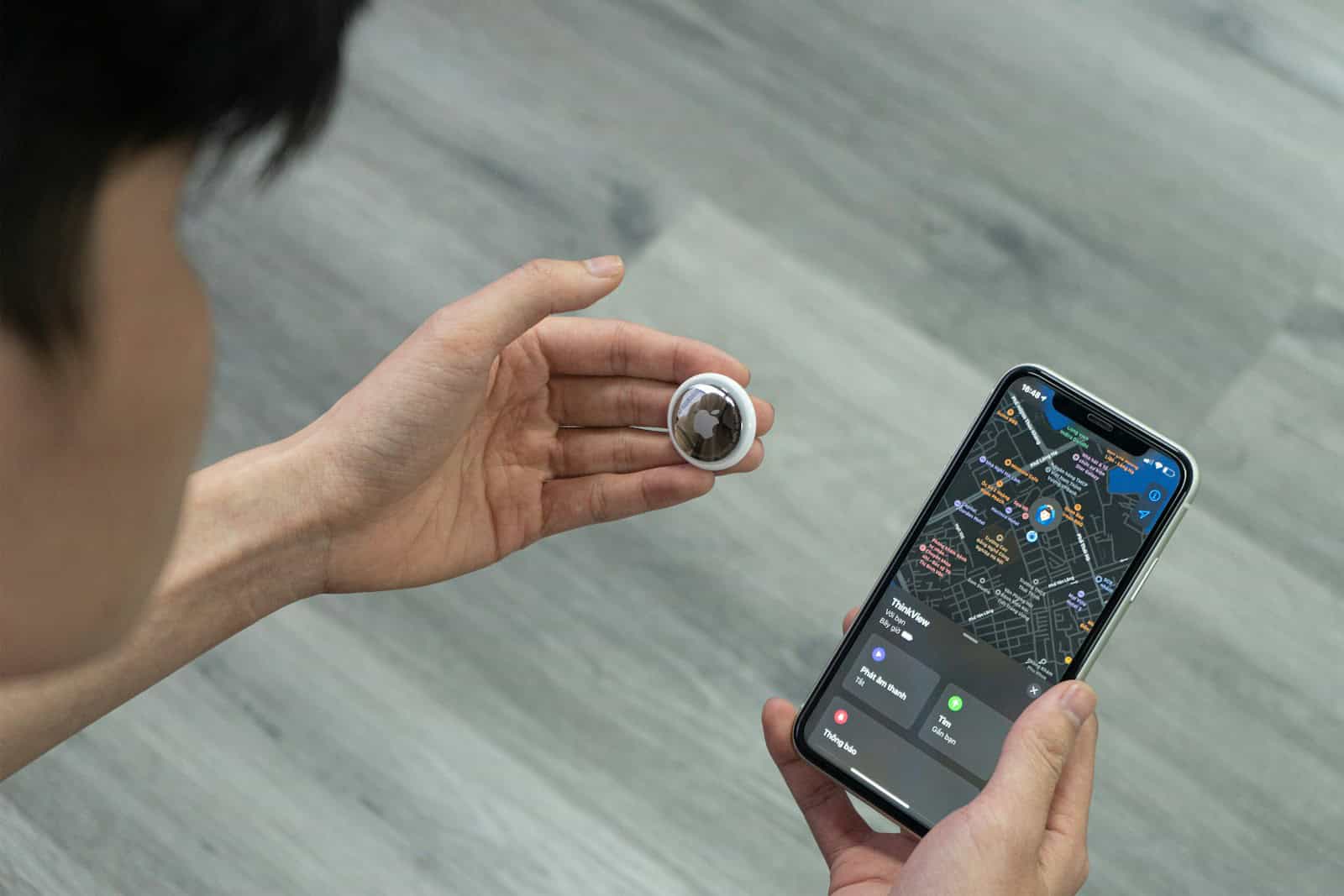Apple’s AirTags have become essential tools for keeping track of valuable items since their introduction. Setting up these small tracking devices is surprisingly simple and takes just minutes to complete. To set up a new AirTag in 2025, remove the battery tab, hold it near your iPhone, tap Connect on the screen, and follow the on-screen instructions to name your item and register it to your Apple ID.
The Find My app integration remains central to the AirTag experience, allowing users to locate tagged items with precision tracking technology. Recent updates have enhanced performance and battery life while maintaining the seamless connection with Apple devices. The setup process still works through the Find My app, where you can assign custom names to each AirTag and attach them to keys, wallets, luggage, or any item you don’t want to lose.
Here are the steps to set up an Apple AirTag with your iPhone or iPad:
How to Set Up AirTag
1. Make Sure Your Device Is Ready
- You’ll need an iPhone or iPad running iOS 14.5 or later.
- Ensure Bluetooth, Wi-Fi, and Find My are enabled.
- Sign in to iCloud with your Apple ID and enable Two-Factor Authentication.
2. Remove the AirTag Battery Tab
- Take the AirTag out of the box.
- Pull out the plastic tab to activate the battery. You should hear a sound confirming it’s on.
3. Bring the AirTag Close to Your iPhone or iPad
- Hold the AirTag near your device. A setup prompt will automatically appear on the screen (similar to setting up AirPods).
4. Tap “Connect”
- Tap the Connect button when the setup screen pops up.
5. Name Your AirTag
- Choose a name from the list (like Keys, Backpack, or Wallet) or create a Custom Name.
6. Register It to Your Apple ID
- The AirTag will be linked to your Apple ID so only you can track it.
- Tap Continue to confirm.
7. Complete the Setup
- Wait for the setup to finish.
- Tap Done when you see the confirmation screen.
8. Track the AirTag Using the Find My App
- Open the Find My app to view your AirTag’s location, play a sound, or activate Lost Mode.
Note: You can pair up to 16 AirTags to one Apple ID. If you ever want to remove or give it away, you’ll need to unpair it through the Find My app.
Key Takeaways
- Setting up an AirTag requires just removing the battery tab and holding it near your iPhone to connect through the Find My app.
- AirTags use precision tracking technology to help locate lost items through the Find My network and Precision Finding features.
- Apple continues to balance convenience with privacy, implementing features that prevent unwanted tracking while maintaining ease of use.
Overview of Apple AirTag
Apple AirTag is a small tracking device designed to help users keep track of personal items like keys, wallets, and luggage. This compact tracker uses Bluetooth technology and Apple’s Find My network to locate lost items with precision.
Evolution of Apple’s Tracking Device
Apple introduced AirTags in April 2021 after years of rumors about the company developing a tracking solution. Prior to AirTags, Apple had already established the Find My network primarily for locating lost Apple devices like iPhones and MacBooks.
The development of AirTags represented Apple’s expansion into the personal item tracking market, competing with established brands like Tile. What sets AirTags apart is their integration with Apple’s vast network of over a billion active devices worldwide that can anonymously detect lost AirTags.
Since their launch, Apple has made several updates to AirTags, including privacy improvements to prevent unwanted tracking and software enhancements to make them more user-friendly.
AirTag Design and Key Features
AirTags feature a small disc-shaped design with a diameter of about 1.26 inches and weigh just 11 grams. They’re water and dust resistant with an IP67 rating, making them durable for everyday use.
Each AirTag contains a replaceable CR2032 battery that lasts approximately one year. The setup process is remarkably simple – just bring the AirTag near an iPhone, and a connection prompt appears for quick pairing.
Key features include:
- Precision Finding: Using Ultra Wideband technology in newer iPhones to guide users directly to their items
- Built-in speaker: Plays sounds to help locate nearby items
- Privacy protection: Random Bluetooth identifiers that frequently change to prevent tracking
- Personalization options: AirTags can be engraved and attached to various accessories
The Find My app displays the location of tracked items on a map and offers features like Lost Mode, which notifies users when their missing item is detected.
Setting Up Your Apple AirTag
Setting up an Apple AirTag is a straightforward process that requires an Apple device and your Apple ID. The small tracking device offers a simple way to keep tabs on important personal items like keys, wallets, and luggage.
Compatibility With Apple Devices
AirTags require specific Apple devices to function properly. Users need an iPhone running iOS 14.5 or later to complete the setup process. This compatibility extends to iPad models with the appropriate iPadOS version as well.
The pairing process is designed to work seamlessly with newer iPhones that feature the U1 chip, which enables more precise finding capabilities. Apple Watch can also be used to locate AirTags once they’re set up, though initial setup must be done through iPhone or iPad.
Most Apple devices manufactured in the last few years will work with AirTags. Before purchasing, users should verify their device compatibility by checking their iOS version in Settings > General > About.
Associating AirTag with Apple ID
To begin setup, users should hold the AirTag near their iPhone or iPad. The device will automatically detect the AirTag and display a connection prompt on screen. Tapping “Connect” initiates the pairing process.
Users must be signed in with their Apple ID in Settings. If prompted about Apple ID authentication, ensure you’re properly logged in. The system will register the AirTag to your personal Apple ID for security.
During setup, users can name their AirTag based on what it will track. Common names include “Keys,” “Wallet,” or “Backpack.” This name appears in the Find My app.
For shared items, users can add other people to their AirTag. After setup, go to Find My > Items, select the AirTag, and tap “Add Person” to share tracking capabilities.
Installing the Finder Battery
AirTags come with a pre-installed CR2032 battery that typically lasts about one year. When replacement is needed, users can access the battery compartment by pressing down and twisting the stainless steel back counterclockwise.
The battery installation is designed to be simple. Place the new CR2032 battery with the positive side facing up, then align the cover and twist clockwise until it locks.
A successful battery installation is confirmed when the AirTag plays a sound. If no sound occurs, check that the battery is properly seated and has sufficient charge.
Apple recommends using high-quality batteries from reputable manufacturers. Some CR2032 batteries with bitterant coatings may not work properly due to the coating interfering with the electrical contacts.
The Find My App Integration
Apple’s Find My app serves as the central hub for AirTag functionality, allowing users to locate their tagged items easily. The app provides both a streamlined interface for viewing all tracked items and advanced features like Precision Finding that make locating misplaced objects more intuitive.
Using the Items Tab in Find My App
The Items tab in the Find My app is specifically designed to help users track their AirTags and other compatible accessories. To add a new AirTag, users simply need to go to their iPhone’s Home Screen and remove the battery tab from the AirTag if it’s new.
Holding the AirTag near the iPhone will prompt a “Connect” notification to appear on screen. After tapping this, users follow the on-screen instructions to complete setup and assign a name to their AirTag.
Once set up, all AirTags appear in the Items tab. Users can view the current or last known location of each tagged item on a map. The app also allows for customization options like playing sounds to help locate items or marking them as lost.
Precision Finding Feature
Precision Finding is an advanced capability available when using AirTags with iPhone 11, iPhone 12, and newer models. This feature provides specific directional guidance to lost items rather than just showing them on a map.
When activated, Precision Finding uses the iPhone’s camera, ARKit, accelerometer, and gyroscope to create a more interactive finding experience. The screen displays an arrow pointing toward the AirTag’s location along with the approximate distance.
For optimal performance, users should be within Bluetooth range (roughly 30 feet) of the AirTag. The technology combines Ultra Wideband technology with visual, haptic, and audio feedback to guide users directly to their missing item.
This feature works particularly well indoors where GPS might be less accurate. Users simply tap on their AirTag in the Items tab and select “Find” to activate the Precision Finding interface when available.
Enhancements in Tracking Technology
Apple has continuously improved AirTag technology since its release. These improvements focus on better tracking capabilities, security updates, and expanded functionality within the Find My ecosystem.
Understanding Find My Network
The Find My Network serves as the backbone of AirTag functionality. This system uses millions of Apple devices worldwide to create a mesh network that helps locate lost items. When an AirTag is separated from its owner, it sends out secure Bluetooth signals that nearby Apple devices can detect.
These signals are encrypted and anonymous, protecting both the AirTag owner and the relay devices. The network can pinpoint an AirTag’s location even when it’s far from its owner’s iPhone.
Find My Network operates with minimal battery impact on relay devices. The system works in the background without compromising performance or privacy. For travelers, this means lost luggage can potentially be tracked across airports or cities through other Apple users’ devices.
Firmware Updates and New Capabilities
Apple regularly releases firmware updates to enhance AirTag functionality and address security concerns. These updates install automatically when the AirTag is near the owner’s iPhone.
Recent firmware has focused on improving anti-stalking measures. Updates have shortened the time before an AirTag alerts nearby iPhone users of its presence when separated from its owner. The alert sound volume has also been increased for better detection.
To check your AirTag’s firmware version:
- Open the Find My app
- Select the Items tab
- Tap your AirTag
- View the serial number and firmware version
These updates demonstrate Apple’s commitment to balancing tracking utility with privacy protection. Additional firmware improvements have included better integration with iOS features and more precise location reporting.
Anticipated Features in Second-Generation AirTag
According to recent reports, Apple plans to release a second-generation AirTag in 2025 with significant upgrades. The new model may feature triple the tracking range of the current version, dramatically improving its utility.
The AirTag 2 is expected to include enhanced security features to further prevent unwanted tracking. These improvements would address concerns raised by privacy advocates since the original release.
Experts anticipate better battery life and possibly a slimmer design. The new model might also include:
- Improved water resistance
- Louder built-in speaker
- More precise directional finding
- Enhanced integration with Apple Vision Pro and other Apple devices
These upgrades would make the tracking device more versatile for travelers, commuters, and anyone concerned about losing valuable items. The expanded range would be particularly useful in crowded environments like airports and shopping centers.
Security and Privacy Considerations
AirTags offer convenient tracking for personal items, but they also introduce important privacy and security concerns. Apple has implemented several features to protect users from potential misuse while maintaining the product’s usefulness.
Preventing Unwanted Tracking
Apple has continuously improved AirTag safety features to prevent stalking and unwanted tracking. In recent updates, they’ve enhanced warning notifications and added more proactive alerts when an unknown AirTag might be traveling with you.
iOS 17.5 introduces new anti-tracking protections that make it harder for someone to use AirTags maliciously. These updates include faster notifications when an unknown AirTag is detected moving with you and improved precision in determining if an AirTag is actually following you versus coincidentally being nearby.
For iPhone users, unknown AirTags will trigger alerts on your device. Android users can download the “Tracker Detect” app from Google Play Store to scan for AirTags that might be traveling with them.
To further enhance privacy, Apple has adjusted the sound alerts on AirTags to be louder and more noticeable.
Responding to Unknown AirTag Alerts
If you receive an “Unknown AirTag” alert on your device, don’t panic but take it seriously. The notification includes an option to play a sound to help locate the AirTag nearby.
When you find an unknown AirTag, you can:
- Tap it with an NFC-capable device to view the serial number and contact information of the owner (if they chose to share it)
- Disable it by removing the battery (twist the back counterclockwise and remove the CR2032 battery)
- Contact local law enforcement if you believe someone is using it to track you maliciously
Apple has worked with safety groups to create resources for those who suspect they’re being tracked. These include step-by-step guides and support information.
If you receive repeated alerts about the same AirTag, consider changing your routine temporarily and documenting when and where the alerts occur.
Comparative Analysis With Competing Trackers
The market for location trackers offers several options with different features and capabilities. When comparing AirTag with competitors like Tile and Samsung SmartTag, several key differences emerge in setup process, network size, and tracking capabilities.
AirTag vs Tile and Others
Apple’s AirTag offers the most streamlined setup experience among tracking devices. Users simply hold the AirTag near their iPhone or iPad, and a notification appears with setup instructions. This simplicity contrasts with Tile and other trackers that require more steps.
For tracking performance, AirTag leverages Apple’s vast network of devices. Testing shows AirTag can receive 10-20 location updates per hour when 30-70 Apple devices are nearby. This network advantage gives AirTag superior coverage in populated areas compared to Tile.
One important limitation: unlike GPS trackers, AirTag doesn’t provide real-time tracking capabilities. It can’t track movements in real time or create detailed movement maps, which some competing products might offer.
Expert Opinions and User Reviews
Tech analyst Mark Gurman reports that Apple plans significant improvements for AirTag 2, expected in 2025. The new model may feature an enhanced UWB (Ultra-Wideband) chip allowing users to locate tags from three times farther away than the current version.
In comparative testing by Tech Gear Lab, AirTag ranked highly among Bluetooth trackers in 2025. Reviewers consistently praise its seamless setup process and reliable performance within the Apple ecosystem.
Many users appreciate AirTag’s compact design and battery life. However, some note that its usefulness diminishes significantly for Android users since it’s optimized for Apple devices.
The price point remains competitive with Tile models, though users must consider ecosystem compatibility when making their choice.
Future of AirTags in the Apple Ecosystem
Apple’s AirTag technology continues to evolve within the broader ecosystem of Apple products. The tracking device appears to be getting a significant update in 2025 that will enhance its capabilities and integration with other Apple devices.
Market Trends and User Adoption
Apple AirTags have gained popularity since their introduction, with many users attaching them to valuable items like keys, luggage, and backpacks. According to recent reports, Apple plans to release AirTag 2 in 2025 with “considerable” upgrades to its tracking capabilities.
The new model is expected to feature an improved ultrawide band chip that could triple the range of precision finding. This enhancement would make AirTags even more effective at locating items around the home or in crowded public spaces.
The AirTag ecosystem continues to expand as third-party accessories like keychains, luggage tags, and pet collars have flooded the market. These accessories make it easier to attach AirTags to various items.
As Apple continues to strengthen its privacy features across devices, AirTags are likely to receive updated security measures to prevent unwanted tracking while maintaining their effectiveness for legitimate use cases.
Frequently Asked Questions
AirTags can sometimes be tricky to set up and maintain. Here are answers to common questions that users have about setting up, resetting, and troubleshooting these helpful tracking devices.
How can I set up an AirTag on my iPhone?
Setting up an AirTag is a straightforward process that takes just a few minutes. First, remove the battery tab from the AirTag, which will activate it with an audible beep.
Hold the AirTag close to your iPhone, and a connection prompt should automatically appear on your screen. Tap “Connect” when this appears.
You’ll then be asked to name your AirTag. Choose something descriptive that helps you remember what item it’s attached to, like “Keys” or “Backpack,” then tap Continue to complete the setup.
What are the steps to reset an AirTag?
Resetting an AirTag may be necessary if you want to give it to someone else or solve certain connection issues. The process is simple but requires physical manipulation of the device.
Press down on the stainless steel battery cover and rotate it counterclockwise until it stops. Remove the cover and battery.
Replace the battery, then press down until you hear a sound. Repeat this process five times total—remove and replace the battery, pressing until you hear a sound each time. After the fifth time, your AirTag will be reset.
Why is my AirTag not connecting and how can I fix it?
An AirTag may fail to connect for several reasons. The most common issue is that Bluetooth or location services are disabled on your iPhone.
Ensure your iPhone has the latest iOS version installed, as outdated software can cause compatibility problems. Also check that Bluetooth and location services are turned on in your Settings app.
Sometimes simply restarting your iPhone can resolve connection issues. If problems persist, try removing the AirTag battery and reinserting it to force a restart of the device.
How do I reconnect an AirTag that has been disconnected?
Reconnecting a disconnected AirTag follows a similar process to the initial setup. Hold the AirTag near your iPhone and wait for the connection prompt to appear.
If no prompt appears, open the Find My app, select the Items tab, and tap “Add Item” or the plus icon. Choose “Add AirTag” and follow the on-screen instructions.
Make sure your AirTag has a functioning battery. If you’ve tried these steps without success, you may need to reset the AirTag completely following the reset steps mentioned earlier.
What could be the reasons for an AirTag’s location not updating?
AirTags rely on the Find My network to update their location. If your AirTag’s location isn’t refreshing, it might be out of range of any Apple devices.
Battery depletion is another common reason for location updates to stop. AirTag batteries typically last about a year, but heavy usage can shorten this timeframe.
Signal interference or being in a remote location with few Apple devices nearby can also prevent location updates. The AirTag may be in an area with poor network coverage or surrounded by materials that block Bluetooth signals.
Is it possible to connect an AirTag without the pull tab, and how?
Yes, you can connect an AirTag even if you’ve already removed the pull tab. The tab is only present for new AirTags to prevent battery drain before first use.
To connect without the pull tab, simply hold the AirTag near your iPhone and wait for the connection prompt. If no prompt appears, open the Find My app and manually add the AirTag as described earlier.
If the AirTag doesn’t respond at all, the battery may need replacement. AirTags use standard CR2032 batteries, which are widely available at most electronics or grocery stores.






